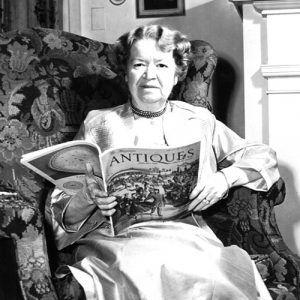calsfoundation@cals.org
Louisa Watkins Wright Loughborough (1881–1962)
aka: Louise Loughborough
Louisa Watkins Wright Loughborough was a pioneer in the field of historic preservation in Arkansas. Inspired by her involvement in the Mount Vernon Ladies Association of the Union, she worked to beautify the Old State House and related grounds in Little Rock (Pulaski County) and subsequently founded the Arkansas Territorial Restoration (now the Historic Arkansas Museum), the first state-supported history museum in Arkansas.
Louisa Loughborough (most often called Louise) was born Louisa Wright in Little Rock to Louisa Watkins and William Fulton Wright, a noted Confederate veteran. She could trace her family lineage through state leaders, such as Arkansas Supreme Court Justice George Claiborne Watkins and William Savin Fulton, Arkansas’s last territorial governor and, later, a United States senator.
She was educated in Little Rock schools and married J. Fairfax Loughborough on October 21, 1902. He was an attorney with Rose, Hemingway, Cantrell and Loughborough, which later became the Rose Law Firm. The Loughborough’s moved to the new Pulaski Heights suburb, and she engaged herself in civic activities. She was a charter member of the Little Rock Garden Club and a member of the National Society of Colonial Dames of America and served as vice regent of the Mount Vernon Ladies Association of the Union, the organization that restored and maintains the home of George Washington.
Loughborough’s involvement in historic structures in Little Rock began when the Little Rock Garden Club sought to improve the appearance of the War Memorial Building (Old State House) and its grounds in 1928. The grounds were littered with signs and monuments, and the roof of the Greek Revival–style building sported figurative statues of Law, Justice, and Mercy, which had been installed above the pediment after being salvaged from the Arkansas exhibit at the Philadelphia Centennial of 1876. To take the façade of the edifice back to its original 1830s appearance, Loughborough had the statues removed—without the permission of the War Memorial Commission, which had legal authority over the building.
In 1935, Loughborough was appointed to the Little Rock Planning Commission, and it was in this role that she first heard about the plan to condemn the half-block of houses that she had grown up admiring on Cumberland and East 3rd streets. Although the neighborhood had fallen on hard times, becoming a red-light district and slum, Loughborough feared the loss of several historic structures, including the Hinderliter House, the oldest building in Little Rock and thought to be Arkansas’s last territorial capitol. She mobilized a group of civic leaders to save these buildings. She enlisted the aid of prominent architect Max Mayer and coined the term “town of three capitols” to try to capture the imagination of potential supporters, grouping the “Territorial Capitol” with the Old State House and the State Capitol.
In 1938, Loughborough secured a commitment from Floyd Sharp of the federal Works Progress Administration (WPA) to help with the project, on the condition that the houses be owned by a governmental entity. She persuaded the Arkansas General Assembly to create and support, with general revenues, the Arkansas Territorial Capitol Restoration Commission (Act 388 of 1939). This satisfied Sharp’s condition, and the WPA provided labor and material for the new historic house museum. A private fundraising campaign brought in the remaining monetary support necessary for the completion of the project.
The Arkansas Territorial Restoration opened on July 19, 1941. The project was the first Arkansas agency committed to both the restoration of structures and the interpretation of their history, and it served as a model and inspiration for historic preservation in the state.
As founding Chairman of the Arkansas Territorial Restoration Commission, Louise Loughborough provided daily direction for the museum house complex through the first twenty years of its existence, yielding her authority to architect Edwin B. Cromwell only as her health began to fail. She died in Little Rock on December 10, 1962 and was buried at Mount Holly Cemetery.
For additional information:
Fairman, L. Hartley. “Mt. Vernon ‘First Lady’ in Arkansas.” Arkansas Democrat Sunday Magazine. March 26, 1944, p. 1.
“Instigator of Restoration to Receive Award of Merit.” Arkansas Gazette. March 18, 1955, p. 12A.
“Leader of Territorial Restoration Succumbs.” Arkansas Democrat. December 11, 1962, p. 8.
“Main Leader in Restoration of Territorial Capitol Dies.” Arkansas Gazette. December 11, 1962, p. 10A.
“We give you…Louise Loughborough Who Has Recreated an Arkansas Era.” Arkansas Gazette. March 16, 1950, p. 3B
Worthen, William B. “Louise Loughborough and Her Campaign for ‘Courage and Fineness.’” Pulaski County Historical Review 40 (Summer 1992): 26–33.
William B. Worthen
Historic Arkansas Museum
This entry, originally published in Arkansas Biography: A Collection of Notable Lives, appears in the CALS Encyclopedia of Arkansas in an altered form. Arkansas Biography is available from the University of Arkansas Press.


 Louisa Loughborough
Louisa Loughborough 



Comments
No comments on this entry yet.